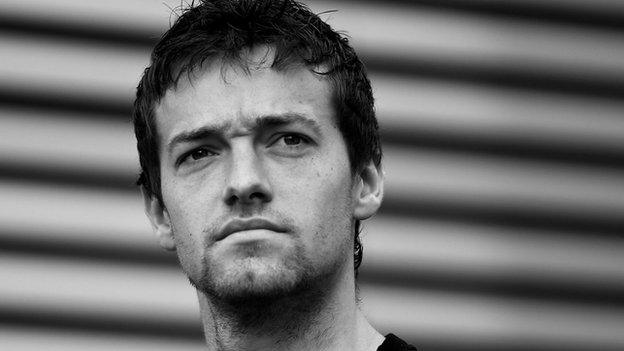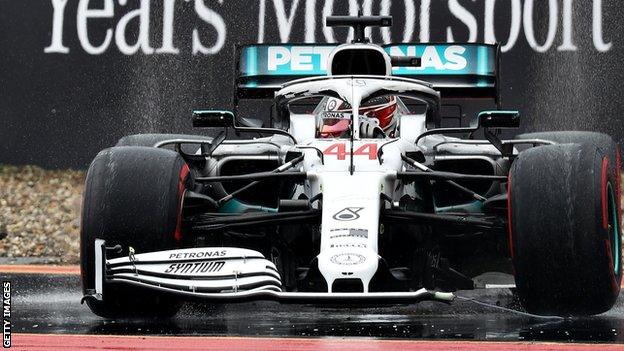Jolyon Palmer column: Fortune favours the cautious in Germany classic
- Published

Former F1 driver Jolyon Palmer, who left Renault during the 2017 season, is part of the BBC team and offers insight and analysis from the point of view of the competitors
The German Grand Prix was a race for the ages, one of the most exciting Formula 1 events there has been, and it was all because of the treacherous and constantly changing conditions.
A wet-dry race is usually that bit more exciting and can often throw up surprising results. At Hockenheim on Sunday, this proved to be the case in the extreme.
Races like this are so challenging because they make enormous demands on every member of the team.
Chief among them are the drivers. They have the most difficult task of keeping the car on track in constantly changing conditions, while pushing to the limit for corner after corner, despite never being absolutely sure where that limit is going to be.
The strategists, meanwhile, have to try to call the pit stops and choose the correct tyres at the right time. This is an incredibly tough task, particularly with varying levels of rain falling throughout the race.
Finally, the mechanics have their work cut out because they are up and down like a yo-yo making pit stops: Max Verstappen stopped five times on his way to victory in the Red Bull; his team-mate Pierre Gasly made four as well.
You have to go back to the famous European Grand Prix at Donington Park in 1993, when Williams driver Alain Prost made a record seven pit stops on his way to third place behind McLaren's Ayrton Senna - who made four - to find similar numbers to these.

Who could have predicted this podium combination before lights out?
Limiting mistakes was paramount
Because making a mistake is so easy in conditions where so much can go wrong, it is as crucial to limit the errors as it is to push to the limits in every area. Ultimately, that's how this race was won.
Verstappen's race wasn't mind blowing, and neither was Sebastian Vettel's to second place. Yet they ended with the biggest smiles at the end of the grand prix, along with Daniil Kvyat, who made a shock return to the podium.
Verstappen had a poor start and suffered a spin when Red Bull made a strategy error in pitting him for medium tyres instead of softs, which would have warmed up sooner in the slippery conditions.
Other than that, though, taking into account all the aspects of the team, Verstappen and Red Bull outperformed the competition.
The Dutchman's pace early on was enough to keep an eye on the leading Mercedes of Lewis Hamilton and Valtteri Bottas, who were running one-two.
But as the major contenders for the win started dropping like flies, Verstappen just stayed there, putting in laps good enough to never be challenged, and not making any further mistakes.
The team judged everything right after the medium-tyre call halfway through, and Verstappen ultimately had an easy enough drive to the win.
Appearances can be deceptive
Vettel's drive to second was nothing spectacular either.
If you just looked at the statistics, it would appear to be one of the best drives in history, coming from 20th - and last - on the grid to second place by the chequered flag.
In truth, though, Vettel lacked pace for much of the grand prix and was languishing in around eighth place from lap six to lap 56, with a high of sixth place at the latter point as Bottas hit the wall ahead.
Kimi Raikkonen in the Alfa Romeo seemed quicker than him in the wetter part of the race. But what Vettel did was produce a mature drive, keeping his mistakes to a minimum.
While many others, including Raikkonen at one point, slithered off the road, particularly at the perilous Turn 16, Vettel just kept plodding away until he reached a point where he was happy and comfortable in the car. Then, in the last part of the race, on soft, dry-weather 'slick' tyres, Vettel came alive.
From there, he exploited the Ferrari's pace advantage over slower midfield rivals - his only competition left bar Verstappen out front - and breezed through for an unlikely second place.
It was the equivalent of a cricket team starting an innings slowly, just hanging in there against the more dangerous bowlers and waiting for the part-time bowlers to come on, and then smacking them around the ground.
Vettel's maturity shone in this race rather than any supreme driving talent and it earned him a standout and much-deserved result, after a lot of bad luck recently.
Leclerc pays the price for aggression
So what happened to the usual major players?
Charles Leclerc, Vettel's team-mate, was the first serious player to find the barriers, just after switching to slicks on lap 27.
His was a race in complete contrast to Vettel's. Like the German, he also had a problem in qualifying, and had to start from 10th on the grid. But he roared up to fourth place in the opening handful of laps, and then had the pace to be challenging for a win, even before other drivers hit trouble.
By the time he switched to slicks, Leclerc was in a genuine second place, behind early leader Hamilton, but his aggressive mentality was ultimately not what this race was about.
Leclerc had already nearly come unstuck a couple of times at Turn 16, which was slippery and critically had the equivalent of an ice rink as its run-off area, because of the oils and rubber deposited on the drag strip that is there.
Finally, through all the bravado of his race, Leclerc pushed one step too far and found the barriers. He accepted the blame for the incident, and called the run-off area unacceptable as well.
In reality, though, this was a moment that highlighted his inexperience once more.
Leclerc is undoubtedly super-talented and will surely win a race before long. But sometimes in his youthful exuberance he can be found guilty of overdriving.
His crash in Baku qualifying was an example, taking too many risks in overtaking when trying to make up ground after Ferrari had messed up his qualifying in Monaco was another. This race is the latest one.
But the 21-year-old is nonetheless on a superb trajectory, and his pain will be softened in the fact that, unlike Vettel when he crashed out of the lead in Germany last year, he was by no means the only driver to find the wall, particularly at that part of the circuit.

"I don't really care where everyone else finished," Hamilton said. "I was in the lead and I finished pretty much last."
An unusually chaotic day at Mercedes
Mercedes looked set for a win, particularly in the hands of Hamilton, but he too proved just how slippery Turn 16 was - and how easy it was to make a mistake like Leclerc's - as he slithered off on the same tyres a lap later, under safety-car conditions.
This was the beginning of the end for Hamilton. He hit the wall at a time when he shouldn't have been pushing at all, then was forced into pitting in a manner against the rules, which earned him a five-second penalty.
To compound matters, this time it was the Mercedes pit wall and mechanics who were all at sea in a race.
No doubt they were surprised at Hamilton's swift decision to pit, and they didn't know the extent of the damage either, but it was chaos in the Mercedes garage, a team who are usually serenely calm and methodical.
A pit stop nearly a minute long followed and Hamilton tumbled down the order. But his difficult race was compounded by further Mercedes strategy errors.
Hamilton could have somehow still been in contention to win, but Mercedes failed to pit him and Bottas under a late safety car. They then waited too long to pit Hamilton when slicks were the obvious choice shortly after that, and he then fell out of the points positions.
As a driver in this situation, with the laps ticking down, it is easy to overdrive, and Hamilton became the latest man to do so, in a race in which survival was key.
He lost it at Turn One and ruled himself out of any further contention, but at least got back to the pits, unlike Bottas.
Bottas was desperate to pass Lance Stroll's Racing Point and earn a podium, which would have helped him reduce his championship deficit to Hamilton.
But as the Finn was getting frustrated stuck behind the slower midfield car, he dropped a wheel onto the wet part of the track at Turn One and hit the wall, putting him out on the spot.
The balance of risk and reward
It was the sort of race F1 has not put on for a long time, with so many incidents, safety cars and changing weather conditions.
Anyone who completed this race without issue scored points in the end but it's never easy to judge this from the outset.
It's easy to say in hindsight, but it's just so hard for the drivers to judge how hard to push and how much risk to take when they are lining up at the start of the race.
For the midfielders, though, the strategy gamble is always a bigger lure, because the risk-reward equation is weighed in their favour. And with so many front-runners dropping out, it was Kvyat and Stroll who made the most of it, to finish third and fourth.
Ironically, these two who looked sublime at the end actually ended up in this position because they were further back and had nothing to lose with 20 laps to go.
Stroll was right at the back, ahead of only Robert Kubica's Williams when he pitted for slicks, and behind George Russell in the other Williams. Kvyat was ninth, five places behind Toro Rosso team-mate Alexander Albon, who also had a tremendous drive.
Inevitably, the drivers further up the order didn't risk fitting slicks as early as those further back, and Stroll's mediocre first two-thirds of the race ultimately gave him the lead for a moment.
Credit to both drivers, though. They got themselves into strong positions and didn't make any substantial mistakes thereafter.
All in all this is the sort of race people love. There was uncertainty right up to the last lap, and it even ended with the feel-good factor of three delighted drivers on an unlikely podium. It was a classic.